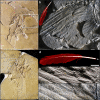Evidence corroborates identity of isolated fossil feather as a wing covert of Archaeopteryx
- PMID: 32999314
- PMCID: PMC7528088
- DOI: 10.1038/s41598-020-65336-y
Evidence corroborates identity of isolated fossil feather as a wing covert of Archaeopteryx
Abstract
The historic fossil feather from the Jurassic Solnhofen has played a pivotal but controversial role in our evolutionary understanding of dinosaurs and birds. Recently, a study confirmed the diagnostic morphology of the feather's original calamus, but nonetheless challenged the proposed identity as an Archaeopteryx covert. However, there are errors in the results and interpretations presented. Here we show that the feather is most likely an upper major primary covert, based on its long calamus (23.3% total length) and eight other anatomical attributes. Critically, this hypothesis is independently supported by evidence of similar primary coverts in multiple specimens of Archaeopteryx-including from the same fossil site and horizon as the isolated feather. We also provide additional insights, such as an updated colour reconstruction of the entire feather as matte black, with 90% probability. Given the isolated nature of the fossil feather, we can never know the anatomical and taxonomic provenance with 100% certainty. However, based on all available evidence, the most empirical and parsimonious conclusion is that this feather represents a primary covert from the ancient wing of Archaeopteryx.
Conflict of interest statement
The authors declare no competing interests.
Figures






Similar articles
-
Detection of lost calamus challenges identity of isolated Archaeopteryx feather.Sci Rep. 2019 Feb 4;9(1):1182. doi: 10.1038/s41598-018-37343-7. Sci Rep. 2019. PMID: 30718905 Free PMC article.
-
New evidence on the colour and nature of the isolated Archaeopteryx feather.Nat Commun. 2012 Jan 24;3:637. doi: 10.1038/ncomms1642. Nat Commun. 2012. PMID: 22273675
-
Primitive wing feather arrangement in Archaeopteryx lithographica and Anchiornis huxleyi.Curr Biol. 2012 Dec 4;22(23):2262-7. doi: 10.1016/j.cub.2012.09.052. Epub 2012 Nov 21. Curr Biol. 2012. PMID: 23177480
-
The evolutionary origin and diversification of feathers.Q Rev Biol. 2002 Sep;77(3):261-95. doi: 10.1086/341993. Q Rev Biol. 2002. PMID: 12365352 Review.
-
The morphological basis of the arm-to-wing transition.J Hand Surg Am. 2008 Feb;33(2):277-80. doi: 10.1016/j.jhsa.2007.11.020. J Hand Surg Am. 2008. PMID: 18294556 Review.
References
-
- von Meyer, H. Vogel-Feder und Palpipes priscus von Solenhofen. Neues Jahrbuch für Mineralogie, Geognosie, Geologie und Petrefakten-Kunde.1861, 561 (1861a).
-
- von Meyer, H. Archaeopteryx lithographica (Vogel-Feder) und Pterodactylus von Solenhofen. Neues Jahrbuch für Mineralogie, Geognosie, Geologie und Petrefakten-Kunde.1861, 678–679 (1861b).
-
- von Meyer, H. Archaeopteryx lithographica aus dem lithographischen Schiefer von Solenhofen. Palaeontographica10(2), 53–56; Plate VIII, Fig. 3 (1862). (English translation, with redrawn figure: von Meyer, H. On the Archæopteryx lithographica, from the lithographic slate of Solenhofen. Annals and Magazine of Natural History9(53), 366–370 (1862).)
-
- Wellnhofer, P. Archaeopteryx. The Icon of Evolution. (Verlag Dr. Friedrich Pfeil, 2009).
-
- Wellnhofer, P. Archaeopteryx. Der Urvogel von Solnhofen. (Verlag Dr. Friedrich Pfeil, 2008).
Publication types
LinkOut - more resources
Full Text Sources

